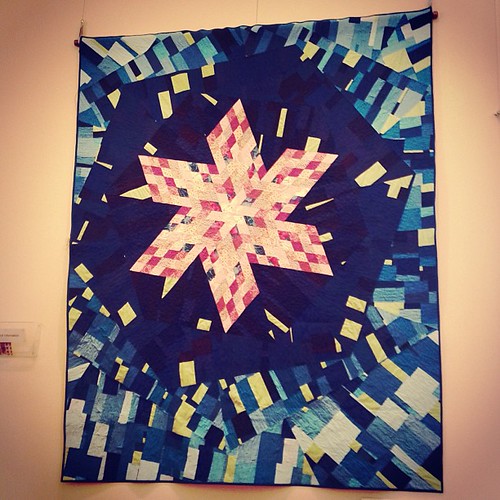In my last post I mentioned that I started by making the 60-degree diamonds from mostly pink prints. I had cut a stack of 2 1/2" width-of-fabric strips almost two years ago for a project I later abandoned. But seeing that stack of fabric haunted me, and I decided to strip piece some diamonds, then follow where inspiration led.
I strip pieced sets of 8 width-or-fabric prints in a manner similar to how you would strip piece diamonds for a lone star quilt. But here I used random strips and 60-degree angles, where a lone star requires 45-degree angles and usually a careful progression of prints.
As I pieced the strips together I offset the edges by about an inch. I trued the first angle edge by pressing and straightening the the panel as much as possible (some waviness is inevitable), aligning the ruler's 60-degree line with the center seam, and slicing off the edge.
I sliced the diamond rows by aligning the ruler's 2 1/2" line with the cut edge, and the 60-degree line with the central seam.
To account for the waviness, I re-flattened and trued the cut edge after every two diamond strips. (I found that distortions multiplied quickly if I wasn't careful to keep the edge true.)
I ended up with a whole lot of diamonds -- far more than I used in this quilt -- and considered using more in the quilt top, with more stars in various sizes. As it turned out a little bit of pink goes a long way for me, so I opted for one star and the rest of the pink strips are waiting for another project (or two or three).
It took a little practice and a lot of careful pinning to get the diamond points to match. Once I got in the rhythm the six star sections came together pretty quickly.
The blue background made use of a very different process. For each hexagon ring I started with about sixteen somewhat wedge-shaped width-of-fabric strips, varying in width from 5" to 8" or so.
Also, for each ring, one of the strips was the light green (Kona Asparagus), and one or two of the strips were reserved from the first cut of the previous ring, and therefore contained smaller pieces of darker fabrics.
Next I sewed the strips into two panels, each approximately 44" square. In the above picture you can see a "reserved" strip in the top panel, second strip from the top.
Then it was time to press the seams, rotate the panels, and cut a new set of slightly wedge-shaped strips, about the same width as before. I pulled out two of the strips to add to the panels for the next ring, mixed with slightly lighter blues.
I finished the panel by sewing, cutting and sewing one more time, yielding a panel approximately 40" x 60", if memory serves.
I drafted large paper templates to cut triangles (for the innermost background) and wedges (for the three outer rings), using the same software I use to do architectural drafting. It would have been a much trickier puzzle to figure out without those tools.
I mentioned in the last post that I miscut the panels for the third ring, aligning the wrong edge of the paper template with the fabric grain (in fact, it's probably the panel-in-progress photographed above). It took a while to get started again and make a new panel. Most of those mis-cut pieces found a home on the back of the quilt.























